Snacks/Single constituents from a particular meal
The most surprising thing was the absence of fresh vegatables. Even carnivores like Adam and his pals said that the reason they went to "The Outback" steakhouse after at most a couple of weeks was because they had a salad bar. It was day four before we saw a menu with a salad on it, and when it arrived, it was covered in bacon bits. |
|||
| cabbage | Crikey. Already I can't remember. These two dishes were on the table at the same time, but I actually don't think we ate them together. The cabbage is just straight raw cabbage. Probably the only raw green vegetable we saw on the whole trip. The other stuff is bean curd. I'm pretty certain the cabbage was a vehicle for something, but if it wasn't bean curd, what was it? | 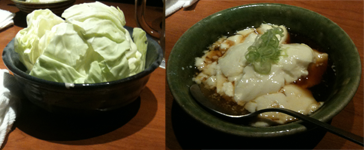 |
|
| curry | Adam threatened me with this thoughout the trip, and I finally checked it off the list inside security at Narita on the way home. Strange dish, we saw it advertized in "curry shops" all over Japan, and it always looked exactly like this: a water-drop-shaped dish with rice at the pointy end, and curry sauce at the bottom, and a sliced-up breaded pork cutlet laid over the top. For English readers, this curry sauce is exactly the same stuff they serve in fish and chip shops when you order it over chips. Washed down with the only dark beer I saw all trip. Not a bad way to go, watching the wide-bodies being shuttled around outside the window. | 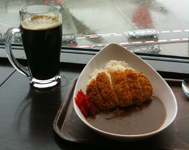 |
|
| green tea cake | I had this for breakfast in Kyoto, and it was so good we both went back and had it again a different morning. Not just a work of art, it had good texture, a beautifully subtle green tea flavor complimented by the embedded hazel nuts and some of the best coffee I've had anywhere (I even brought some home). |  |
|
| green tea ice cream | Had this twice. The first time was perhaps the most interesting. Looked like a regular cone, (you peel the paper off the top first, then the bottom half can just fall off the cone) and it looked like a regular ice cream too, until you bit into it, whereupon it was discovered to be embedded with whole red beans. It doubtless said that on the label, but who could read that? | ||
| inago | 蝗 | Crickets. Yes, crickets. We even asked another guest what they were and she said "crickets." Okay then. As long as they are not 'roaches. I don't do 'roaches. I'm glad they were not the main course, but they were actually pretty good. A nice crunchy vehicle for the teriyaki sauce they were fried in. And what's not to like about that? | 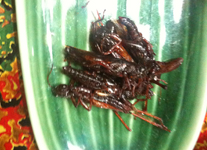 |
| ika | 烏賊 | Squid. This was the picture on the outside of the packet, but it was still something of a surprise to find that the contents really did look remarkably like their picture. We bought the packet in a supermarket for general snacking, but in fact did not open it until returning to the US. The second major surprise was that they were not dried to a crisp, but rather were the constancy of red licorice (Twizzlers). Third, they had a pickled sharpness to them that I could imagine myself rapidly getting a liking for. Fourth, and best of all, the brave souls who opened the packet with me also finished the packet with me. An excellent result. | 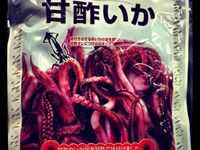 |
| ishidai | Striped beakfish. One minute it was a big striped fish swimming in the aquarium at the end of the restaurant, and the next it was sliced and diced in front of us. Obviously fresh, I found it a little flavorless in comparison to other things we were trying, but fuill marks for presentation. | 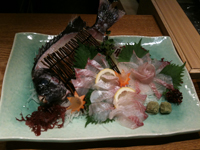 |
|
| katsoubushi | 鰹節 | Dried, fermented, and smoked skipjack tuna. When placed on hot food, the heat waves causes the thin and light katsuobushi to move about, making the food seem alive with the "dancing" katsuobushi. The reason it looks (and feels) so much like (delicious) wood shavings is perhaps related to the fact that the block of katsoubushi itself looks and feels just like a block of wood, and no surprise then that the tool used to shave it looks just like a wood plane. | 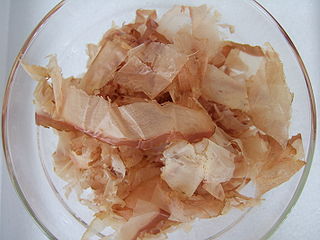 |
| Korean noodles | Yikes! Never mind the table cloth, all that red stuff on the top is chilli. Far and away the hottest thing we had all week. Some of us were dripping with sweat, others refused to even attempt it. Given how popular this dish is with the customers (this was one of the only places we had to queue to get in to) it was surprising that there were not more places like it, or more dishes in other places with more heat. But there we are. | 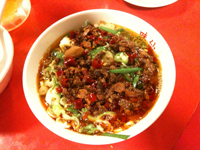 |
|
| maguro | Three different qualities of tuna from different parts of the fish. Working from left to right it got less fatty. The fatty selection was incredibly rich, and delicious, but for everyday work I'm a great fan of the more regular lean cut on the right. But wow, a really interesting plate. | 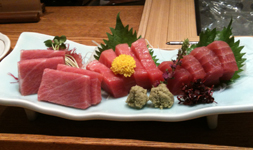 |
|
| nattō | 納豆 | The soy beans are fermented somehow until they go soft and, well, goopy. They also smell. I didn't think they were that pungent, but that plastic cup they are in has a protective sealed lid that had to be peeled off when you were ready to eat it, because the Japanese hate the smell. When you grab some, the goop is stringy enough to stretch from the bowl to your mouth, and once you've separated the mouthful from the rest of the bowl, yes, they are sort of slimy in the mouth. I thought they were interesting. They are one of Adam's least favorite Japanese options, but that seemed to make it all the more important that I was encouraged to try it at least once. |  |
| onigiri | お握り | White rice formed into a triangular shape and wrapped in nori (seaweed). Onigiri is filled with pickled plum, salted salmon, or any other sour or salty ingredient. The neat thing is the plastic wrapper, but I never got the hang of it. The three corners are numbered and you have to tear off and separate the plastic in strict order. Tab 1 has been pulled in the picture, but the plastic not yet pulled away. What I did not realize at the time (and surely this would have helped) is that the plastic is not only protecting the outside, but also separating the nori from the rice so that it does not absorb moisture and become soft. Contact is only made as you unwrap, and now the nori is there to keep your hands dry and to provide a crunchy outside. Brilliant. | 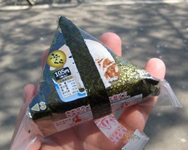 |
| oyaki | おやき | (Honorable cooked thing.) Actually three different honorable cooked things. Nagano province is famous for these fermented buckwheat dumplings where the steep mountains and cold climate limited rice production. Pumpkin, "mountain vegetables", and bean curd. A little dry and bland, the waitress couldn't believe I ordered them all—one or the other was clearly the more normal practice. No wonder. I was the honerable stuffed thing as I waddled out of the restaurant. | 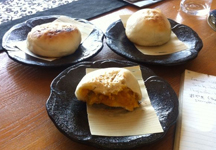 |
| oysters (grilled) | The chef had a little charcoal fire going on the street, and he was turning the oysters over with a pair of industrial-sized chop-sticks. Me: "Lunch." Adam: "Obviously." What else to say? They tasted like charcoal-grilled oysters. I couldn't believe we hadn't done this at home. When I told folks about it back stateside, they couldn't believe it either. "Hell yes, do it all the time. Where've you been?" Now I feel like a chump, but I can't wait to get my new charcoal grill. These babies will be the first thing on it. I even know how to cook them now: throw them on, wait for them to start to open. Eat immediately. | 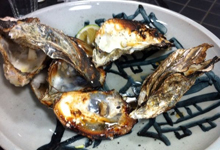 |
|
| ??? | Adam and Alistair called this "popcorn soup." | 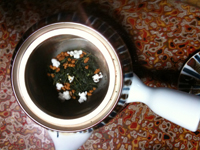 |
|
| takoyaki | 蛸焼 | A ball-shaped snack made of a batter filled with diced octopus (tako) pickled ginger, and green onion then cooked in a takoyaki pan: a griddle made of cast iron with half-spherical moulds. This heavy iron pan evenly heats the takoyaki, which are turned with a pick during the cooking process to pull the uncooked batter to the base of the rounded cavity so that eventually a ball is formed. The cooked takoyaki are brushed with takoyaki sauce, similar to Worcestershire sauce, and mayonnaise and then sprinkled with shavings of dried katsuobushi. |
 |
| teriyaki tuna cheek | Tuna jaw. Wow. One of my favorites all trip. Baked in teriyaki sauce until the meat was falling off the bone, and then you just prodded and poked with your chop-sticks until it was picked clean. A communal dish, it rapidly became something of a competition to see if you could find something the previous guy had overlooked. Absolutely delicious, succulent, flavorful, OMG good. |  |
|
| zarusoba | Soba noodles. For all that I love strong flavors, I can still like subtle ones too. This is one of those. The noodles are served cold on some sort of mat—either a shallow basket as here, or more commonly on the mat you make sushi with—which keeps them well-drained. They are served with miso soup. After seasoning the miso with the right amount of "welsh onions" (scallions), and wasabi, (which in my case of course means emptying everything into the soup) you dunk the noodles in the soup on its way to your mouth. Hot soup, slightly warmed but cold on the inside noodles, spicy liquid, subtely nutty noodles is a mouthful of contrasts. | 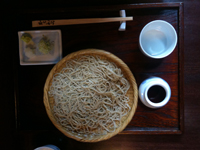 |
|
| perilla (suiso) | Plum sherbet. A little treat/pallete-cleanser after the soba noodles. | 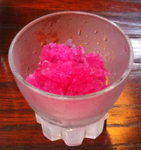 |
|
| quail's eggs | Long prized in Japan for their health-providing properties, they are also a convenient size for eating (whole) with chopsticks. The spicy sprinkles on top, and the creamy sauce they are sitting in combine to create instant egg salad in your mouth. |  |
|
| tomato | The Japanese seem to pride themselves on making things more difficult than they need to be, so no surprise that the tomatoes in this pile were peeled. No denying though that it also adds to the feeling of care and pride in everything they do, making things look and feel decidely shoddy when one gets home. Back to the tomatoes: moorish. Steeped in balsamic vinegar, along with a little black olive and onion. Presentation aside, I'm sure the skinlessness added hugely to the amount of balsamic the tomatoes could soak up. Definately worth it. | 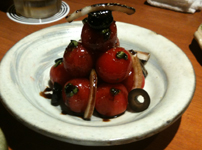 |
|
| ??? | A single piece of sushi, with a couple of strips of the famous Hida beef on top. The street vendor made them up to order, using a blow torch to braize the beef strips. Notice the plate, which is rice-cardboard so you can eat it, or if you throw it way, something else will eat it, or if nothing eats it, will rot/disolve in days or weeks. Brilliant. | 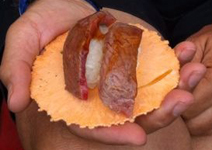 |
|
| ??? | The vendor cracked an egg onto his hot plate, then used a wide spackling blade to smear the egg out into a thin layer about 9 inches long and 4 or 5 wide. Onto this he then added a spoonful of pickled ginger, (something else), and mayonaise. He folded the oval over so there was a straight edge and a semi-circle, then placed this onto one side of a rice-cardboard plate. He used his spackling knife to press a crease across the middle of the plate, then folded it over the egg, creating a sort of Japanese taco. Wrapped in a napkin, it's yours. God knows what happened if there was a line because he was slow, methodical, and somehow made it clear that there was absolutely no way to speed the process up, no matter how aggrevated the line was getting. As usual: delicious. | 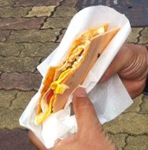 |
|
| yakitori | Food on a stick. This one, asparagus, was actually one course from a varied menu, but we went to other places that only served skewers. Chicken thighs or hearts, beef, fish cartilage, you name it, it was skewered. We sat right in front of the chef and watched her prepare row after row on a little grill. It was on the 5th floor of a building with seven floors of restaurants. You stepped out of the two-person 'vator straight into a different world. Sawdust on the floor. Every member of staff shouted a welcome in unison when they heard the elevator door open. A pair of skewers, shots, beers, everything on the menu was the same price, around $2. 12 pairs of sticks, 6 beers, 2 shots, $40. Great night. |  |
|
| Whole meals | |||
| bento box | We bought a lot of these, and I'm not sure why I have so little documentation. Absolutely the way to eat on the train, they could be bought at all but the smallest stations, both on the platform and in places like Tokyo Station, in what seemed like entire malls. Mostly they were prepackaged, but we did see one store where you could compile your own. They always have rice, and they always have pickles, but of course everything including beer comes with pickles. After that, it could be almost anything else. Like much in Japan, they are prized as much for their appearance as their flavor. Indeed, though I didn't notice any of them, there's an entire sub-species called kyaraben designed to resemble cartoon characters. Not kidding. | 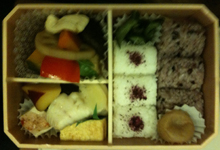 |
|
| breakfast | Breakfast at one of those places where you order from a kiosk with pictures just inside the door, and then hand the ticket to the guy behind the counter. This is about $7-worth of food. Miso and rice of course, and the egg is pretty obvious, but the star of this particular show is the nattō which in the square container at the top. | 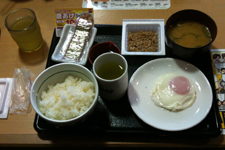 |
|
| minshuko | Evening meal. | 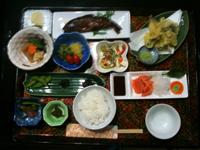 |
|
| Breakfast | 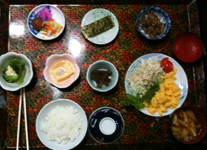 |
||
| ryokan | Evening meal. | 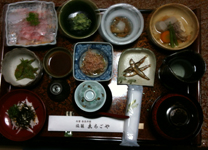 |
|
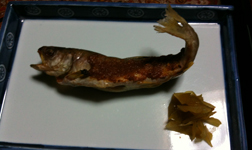 |
|||
 |
|||
| Breakfast |  |
||
| Drink | |||
| coffee | Coffee from a vending machine? Check. HOT coffee from a vending machine? Check again. Red labels hot, blue labels cold. Even I could figure that out. Somewhat harder was black, cream, sugar, cream AND sugar? Fortunately the black ones seemed to be together, and one was called Boss Black. Hot coffee was at a perfect drinking temperature, which made it a tad too warm to hold, but what are you going to do? You got hot coffee in the middle of nowhere didn't you? | 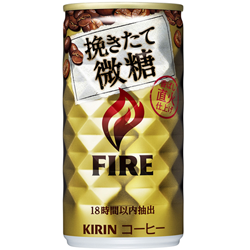 |
|
| And while we're on the subject, one vending machine advertized fresh-brewed filtered coffee, and even had a video screen so you could watch the french press plunging on the grounds, the cup filled, and the top pushed on moments before it appeared in the collection window. Interesting theoretical discussion about whether the screen was really a camera inside the machine or just a video playing over and over to amuse the patron, but the coffee was excellent. And check out the cute little stopper that was clipped in the lid so you could plug the mouth hole to avoid spills. It's a little hard to see against the dark background, but it is plugged into the mouth hole at the top of the picture. | 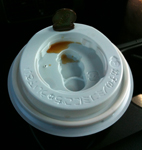 |
||
| "ot co-hee" | Adam: "Tell the lady behind the counter you want 'ot co-hee'" RT: "You are kidding, right?" A: "No, really." I said the lady behind the counter "ot co-hee, please." Laughing soundly at my accent she produced two different-sized cups and raised her eyebrows. I pointed at the larger one. She filled the cup and handed it to me, saying something that of course I did not understand. I showed her a handful of change and she picked out what she needed. Then with a charming little bow and smile she said something obviously flattering and appropriate but totally incomprehensible. I smiled and bowed in return and we were done. I'd had my first conversation, and had a cup of coffee to prove it. It looked just like the vending machine one, but a more satisfying experience. | ||
| Denki Bran | Probably because I was the only one drinking, I chickened out of the glass of beer I was offered with the Denki Bran but it was delicious on its own. (Japanese description for the companion beer: "chaser") Some sort of schnapps-aqua vite, it had a caramel apricot orange flavor that was decidedly moreish. But though I looked, I never did find more. | 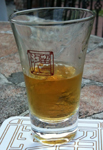 |
|
| lemonade | The only thing here I did not consume personally, but documented because it had the same type of bottle as the ramune and I even caught it on video. |  |
|
| matcha | Green tea. But this powdered stuff, used in the tea ceremony, is not like any green tea I've tasted in Japan or anywhere else. Regular green tea, available in any vending machine tastes as you expect. This stuff, which we were served on a couple of special occasions (unfortunately neither of them a true ceremony) is whisked up into a thick froth, and served in traditional little tea cups. It has a very interesting almost meaty flavor, yet at the same time surprisingly sweet considering nothing else is added. A very special flavor, most befitting of the reverence with which it is held. | 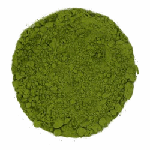 |
|
| Pocari Sweat | This, and another popular brand "Calpis Water" are popular energy drinks with what Eyewitness Travel Japan describes as having "names that conjure up disturbing images for English-speaking foreigners." Indeed. Adam liked it, I tried it. It had that same sweet-salt taste that the original non-flavored energy drinks do here. In short, yes, a sort of sweaty taste. |  |
|
| ramune | "Old-fashioned" apple cider. Sampled as much to be able to watch them open the strange bottle as anything else. The bottle cap was a glass ball trapped inside the neck of the bottle and pressed up against the rim by pressure. The shopkeeper had a little punch tool and used a hammer to break the seal by knocking the ball down into the bottle. The cider was absolutely wonderful. The lighest apple, it tasted like the fragrance of a flower, as if it were in the rose water / elderflower flavor group. Equally subtle fizz, and just a hint of sweetness. |  |
|
| sake | Adam: "How can you tell if it is time for pickles in Japan? Easy: it's ALWAYS time for pickles." "Glass of sake please." "Certainly, sir, and here's the dish of pickles you obviously also wanted then." | 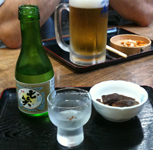 |
|
| sake, by the each | A single serving of sake, sold in its own glass. |  |
|
| sake, in a box | A single serving of sake, served in its own tray. The sake had spilled over into the tray/box. Very sloppy I thought, but I'm cheap, and this was Japan, so the glass was probably as clean on the outside as the inside, and likewise the tray, so when I was finished with the glass, I also drained the tray. Later I discovered that this was a sign of hospitality. Effectively, I'd paid for the glassful, and the excess in the tray was their gift to me. I'm soooo glad I drank it then. | 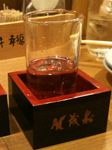 |
|
| shōchū | 焼 酎 | A spirit I drank a lot of because it is so much less well-known than sake. Make no mistake, they are different: sake is brewed, shōchū is distilled. At about 25% shōchū is considerably less potent than, say, whisky or gin, and its flavor relies on its base, which varies. I tried wheat, sugar cane (my favorite) and sweet potato, and I looked for barley which was the one illustrated in my guidebook. Ironically, though I never found a bartender who'd heard of it, Alistair not only had a bottle, but it was the same bottle as the picture in the book. But it was unopened, and it seemed right that it stayed that way. Meanwhile, it shared the gentle flavor of sake, making it just as easy to drink, but that left me ill-prepared for the wallop it packed at twice the alcohol when it was time to go home. Oh yes, and it tended to come in huge bottles. |
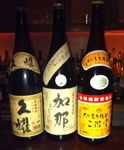 |
| whisky | US distillers are now making excellent gins and vodkas, but so far in my experience their whisky (I'm talking regular whisky here, not Bourbon or Rye) is just plain terrible. So I did not have high hopes for the Japanese efforts, but I was very pleasantly surprised. Mind you it came at a price. Checking it out in the duty free on the way home it was $70-80—30-50% more than high street prices for young single malts back in Massachusetts. On Alistair's recommendation I tried Nikka Taketsuru 17 Year Old. Then I tried it again. Just as good the second time too. |  |
|